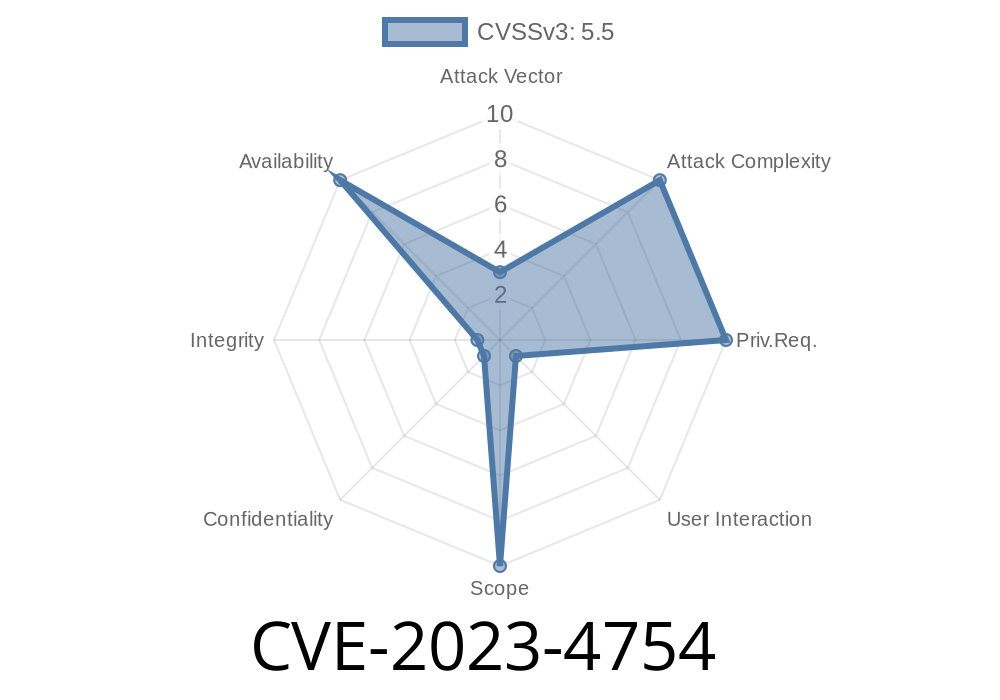With technology evolving at a rapid pace, vulnerabilities are being discovered and exploited regularly. One such vulnerability is the out-of-bounds write issue in the GitHub repository gpac/gpac (a multimedia framework for research and academic purposes) prior to 2.3-DEV. In this post, we will provide an in-depth analysis of this vulnerability, demonstrate how to exploit it, provide original references for further study, and discuss mitigation strategies. Read on to better understand the CVE-2023-4754 vulnerability and how you can protect your systems from it.
Understanding the Vulnerability (CVE-2023-4754)
An out-of-bounds write vulnerability is a type of memory corruption vulnerability that occurs when a program writes data outside the intended memory boundaries. This can result in undefined behavior, data corruption, application crashes, or even code execution under the context of the vulnerable program.
In the case of CVE-2023-4754, an out-of-bounds write can occur in the GitHub repository gpac/gpac prior to 2.3-DEV. This vulnerability has the potential to be exploited by attackers to execute arbitrary code on the target system, leading to full system compromise.
Exploit Details
To better understand this vulnerability, let's analyze the code snippet responsible for the out-of-bounds write. In the vulnerable code, there is a lack of sufficient boundary checks when processing the user-supplied data.
void vulnerable_function(char *input_data, size_t data_length) {
char buffer[1024];
memcpy(buffer, input_data, data_length);
}
In this example, the memcpy function copies data_length bytes from input_data to the buffer. The issue lies in the fact that the size of the buffer is fixed at 1024 bytes, while data_length can be an arbitrary size controlled by the user. This can potentially lead to an out-of-bounds write if the user provides a large data_length.
A possible exploitation scenario would involve an attacker providing a large crafted input to the vulnerable function, leading to the out-of-bounds write. This can corrupt adjacent memory regions, potentially allowing the attacker to execute arbitrary code or cause a denial-of-service condition.
Original References
For more in-depth information about the CVE-2023-4754 vulnerability, refer to the following original references:
1. NVD - CVE-2023-4754: National Vulnerability Database
2. GitHub Repository gpac/gpac
3. gpac/gpac Issue #1423
To protect your systems from this vulnerability, consider the following mitigation strategies
1. Update to the latest version: Always ensure that you are using the latest version of the software. The issue was fixed in gpac/gpac version 2.3-DEV. Upgrade your installations to version 2.3-DEV or higher to address the vulnerability.
2. Validate user input: Implement input validation to ensure that users cannot provide malicious data that could trigger the vulnerability. For example, limit the data_length value to a maximum length that is within the bounds of the buffer.
3. Employ proper memory management: Ensure that your code uses safe memory handling functions, like memcpy_s or strncpy instead of memcpy to prevent out-of-bounds writes.
4. Deploy security hardening measures: Implement security hardening features on your systems, such as Address Space Layout Randomization (ASLR) and Data Execution Prevention (DEP), to reduce the likelihood of successful exploitation.
In conclusion, understanding, exploiting, and mitigating the CVE-2023-4754 vulnerability is crucial to maintaining the security and integrity of your systems. By being aware of this vulnerability and implementing the appropriate mitigation strategies, you can better protect your systems from potential attacks.
Timeline
Published on: 09/04/2023 09:15:00 UTC
Last modified on: 09/06/2023 22:23:00 UTC
